Gebruiker:KoenB/Kladblok
Tabel met projecties[bewerken | brontekst bewerken]
| Projectie | Afbeeldingen | Type | Eigenschappen | Bedenker | Jaartal | Notities |
|---|---|---|---|---|---|---|
| Kadratische platkaart = equidistante cilinderprojectie |

|
Cylindrisch | Afstandsgetrouw | Marinus van Tyrus | 120 | Eenvoudige afbeelding van geografische lengte en breedte; afstandsgetrouw langs de meridianen. |
| Mercator = Wright |

|
Cylindrisch | Hoekgetrouw | Gerardus Mercator | 1569 | Lijnen van constante kompaskoers zijn rechten, wat van nut is voor navigatie. De schaal neemt af met de afstand tot de evenaar, zodanig dat de polen niet in beeld kunnen komen. |
| Braun vergelijkbaar met James Gall |

|
Cylindrisch | Compromis | Carl Braun | 1867 | Geïnspireerd op de Mercatorprojectie, maar dan met de polen in beeld. De standaardparallel is hier de evenaar; James Gall heeft deze op 45° N/Z. |
| Orthografische cilinderprojectie van Lambert | Cylindrisch | Oppervlaktegetrouw | Johann Heinrich Lambert | 1772 | Rakend aan de evenaar. Kaartverhouding 1 : 3.14 (pi). | |
| Gall–Peters | 
|
Cylindrisch | Oppervlaktegetrouw | James Gall | 1855 | Verticaal uitgerekte versie van de orthografische cilinderprojectie van Lambert. Snijdend door de parallellen 45° N/Z. De Balthasartprojectie is een variant hierop, snijdend door de 50°-parallellen. |
| Sinusoidal = Sanson-Flamsteed = Mercator equal-area |

|
Pseudocylindrical | Equal-area | (Several; first is unknown) | 1600
(c.) |
Meridians are sinusoids; parallels are equally spaced. Aspect ratio of 2:1. Distances along parallels are conserved. |
| Mollweide = elliptical = Babinet = homolographic |

|
Pseudocylindrical | Equal-area | Karl Brandan Mollweide | 1805 | Meridians are ellipses. |
| Eckert II | 
|
Pseudocylindrical | Equal-area | Max Eckert-Greifendorff | 1906 | |
| Eckert IV | 
|
Pseudocylindrical | Equal-area | Max Eckert-Greifendorff | 1906 | Parallels are unequal in spacing and scale; outer meridians are semicircles; other meridians are semiellipses. |
| Eckert VI | 
|
Pseudocylindrical | Equal-area | Max Eckert-Greifendorff | 1906 | Parallels are unequal in spacing and scale; meridians are half-period sinusoids. |
| Ortelius oval | 
|
Pseudocylindrical | Battista Agnese | 1540 |
Meridians are circular.[1] | |
| Goode homolosine | 
|
Pseudocylindrical | Equal-area | John Paul Goode | 1923 | Hybrid of Sinusoidal and Mollweide projections. Usually used in interrupted form. |
| Kavrayskiy VII | 
|
Pseudocylindrical | Compromise | Vladimir V. Kavrayskiy | 1939 | Evenly spaced parallels. Equivalent to Wagner VI horizontally compressed by a factor of . |
| Robinson | 
|
Pseudocylindrical | Compromise | Arthur H. Robinson | 1963 | Computed by interpolation of tabulated values. Used by Rand McNally since inception and used by NGS 1988–98. |
| Natural Earth | 
|
Pseudocylindrical | Compromise | Tom Patterson | 2011 | Computed by interpolation of tabulated values. |
| Tobler hyperelliptical | 
|
Pseudocylindrical | Equal-area | Waldo R. Tobler | 1973 | A family of map projections that includes as special cases Mollweide projection, Collignon projection, and the various cylindrical equal-area projections. |
| Wagner VI | 
|
Pseudocylindrical | Compromise | K.H. Wagner | 1932 | Equivalent to Kavrayskiy VII vertically compressed by a factor of . |
| Collignon | Pseudocylindrical | Equal-area | Édouard Collignon | 1865 (c.) | Depending on configuration, the projection also may map the sphere to a single diamond or a pair of squares. | |
| HEALPix | 
|
Pseudocylindrical | Equal-area | Krzysztof M. Górski | 1997 | Hybrid of Collignon + Lambert cylindrical equal-area |
| Boggs eumorphic | 
|
Pseudocylindrical | Equal-area | Samuel Whittemore Boggs | 1929 | The equal-area projection that results from average of sinusoidal and Mollweide y-coordinates and thereby constraining the x coordinate. |
| Craster parabolic =Putniņš P4 |
Pseudocylindrical | Equal-area | John Craster | 1929 | Meridians are parabolas. Standard parallels at 36°46′N/S; parallels are unequal in spacing and scale; 2:1 Aspect. | |
| Flat-polar quartic = McBryde-Thomas #4 |
Pseudocylindrical | Equal-area | Felix W. McBryde, Paul Thomas | 1949 | Standard parallels at 33°45′N/S; parallels are unequal in spacing and scale; meridians are fourth-order curves. Distortion-free only where the standard parallels intersect the central meridian. | |
| Quartic authalic | Pseudocylindrical | Equal-area | Karl Siemon
Oscar Adams |
1937
1944 |
Parallels are unequal in spacing and scale. No distortion along the equator. Meridians are fourth-order curves. | |
| The Times | Pseudocylindrical | Compromise | John Muir | 1965 | Standard parallels 45°N/S. Parallels based on Gall orthographic, but with curved meridians. Developed for Bartholomew Ltd., The Times Atlas. | |
| Loximuthal | 
|
Pseudocylindrical | Karl Siemon, Waldo Tobler | 1935, 1966 | From the designated centre, lines of constant bearing (rhumb lines/loxodromes) are straight and have the correct length. Generally asymmetric about the equator. | |
| Aitoff | 
|
Pseudoazimuthal | Compromise | David A. Aitoff | 1889 | Stretching of modified equatorial azimuthal equidistant map. Boundary is 2:1 ellipse. Largely superseded by Hammer. |
| Hammer = Hammer-Aitoff variations: Briesemeister; Nordic |

|
Pseudoazimuthal | Equal-area | Ernst Hammer | 1892 | Modified from azimuthal equal-area equatorial map. Boundary is 2:1 ellipse. Variants are oblique versions, centred on 45°N. |
| Winkel tripel | 
|
Pseudoazimuthal | Compromise | Oswald Winkel | 1921 | Arithmetic mean of the equirectangular projection and the Aitoff projection. Standard world projection for the NGS 1998–present. |
| Van der Grinten | 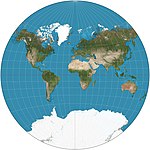
|
Other | Compromise | Alphons J. van der Grinten | 1904 | Boundary is a circle. All parallels and meridians are circular arcs. Usually clipped near 80°N/S. Standard world projection of the NGS 1922–88. |
| Equidistant conic projection = simple conic |
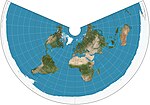
|
Conic | Equidistant | Based on Ptolemy’s 1st Projection | 100 (c.) | Distances along meridians are conserved, as is distance along one or two standard parallels[2] |
| Lambert conformal conic | 
|
Conic | Conformal | Johann Heinrich Lambert | 1772 | |
| Albers conic | 
|
Conic | Equal-area | Heinrich C. Albers | 1805 | Two standard parallels with low distortion between them. |
| Werner | 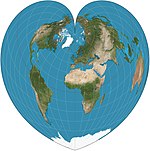
|
Pseudoconical | Equal-area | Johannes Stabius | 1500 (c.) | Distances from the North Pole are correct as are the curved distances along parallels. |
| Bonne | 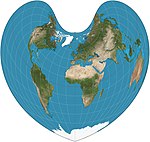
|
Pseudoconical, cordiform | Equal-area | Bernardus Sylvanus | 1511 | Parallels are equally spaced circular arcs and standard lines. Appearance depends on reference parallel. General case of both Werner and sinusoidal |
| Bottomley | 
|
Pseudoconical | Equal-area | Henry Bottomley | 2003 | Alternative to the Bonne projection with simpler overall shape Parallels are elliptical arcs |
| American polyconic | 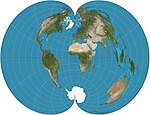
|
Pseudoconical | Ferdinand Rudolph Hassler | 1820 (c.) | Distances along the parallels are preserved as are distances along the central meridian. | |
| Azimuthal equidistant =Postel zenithal equidistant |
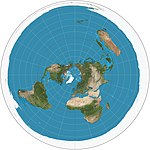
|
Azimuthal | Equidistant | Abū Rayḥān al-Bīrūnī | 1000 (c.) | Used by the USGS in the National Atlas of the United States of America.
Distances from centre are conserved. |
| Gnomonic | 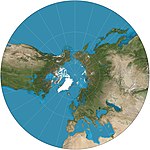
|
Azimuthal | Gnomonic | Thales (possibly) | 580 BC (c.) | All great circles map to straight lines. Extreme distortion far from the center. Shows less than one hemisphere. |
| Lambert azimuthal equal-area | 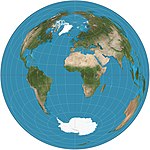
|
Azimuthal | Equal-area | Johann Heinrich Lambert | 1772 | The straight-line distance between the central point on the map to any other point is the same as the straight-line 3D distance through the globe between the two points. |
| Stereographic | 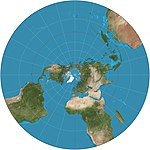
|
Azimuthal | Conformal | Hipparchos (deployed) | 200 BC (c.) | Map is infinite in extent with outer hemisphere inflating severely, so it is often used as two hemispheres. Maps all small circles to circles, which is useful for planetary mapping to preserve the shapes of craters. |
| Orthographic | 
|
Azimuthal | Hipparchos (deployed) | 200 BC (c.) | View from an infinite distance. | |
| Vertical perspective | 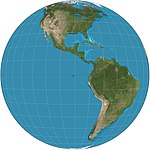
|
Azimuthal | Matthias Seutter (deployed) | 1740 | View from a finite distance. Can only display less than a hemisphere. | |
| Two-point equidistant | 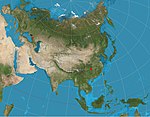
|
Azimuthal | Equidistant | Hans Maurer | 1919 | Two "control points" can almost be arbitrarily chosen. The two straight-line distances from any point on the map to the two control points are correct. |
| Peirce quincuncial | 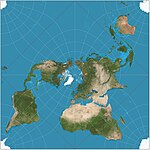
|
Other | Conformal | Charles Sanders Peirce | 1879 | |
| Guyou hemisphere-in-a-square projection | 
|
Other | Conformal | Émile Guyou | 1887 | |
| Adams hemisphere-in-a-square projection | 
|
Other | Conformal | Oscar Sherman Adams | 1925 | |
| B.J.S. Cahill's Butterfly Map | 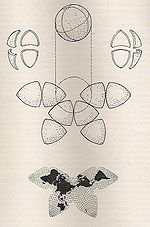
|
Polyhedral | Compromise | Bernard Joseph Stanislaus Cahill | 1909 | Projects the globe onto an octahedron with symmetrical components and contiguous landmasses that may be displayed in various arrangements |
| Cahill-Keyes projection | 
|
Polyhedral | Compromise | Gene Keyes | 1975 | Projects the globe onto a truncated octahedron with symmetrical components and contiguous land masses |
| Waterman butterfly projection | 
|
Polyhedral | Compromise | Steve Waterman | 1996 | Projects the globe onto a truncated octahedron with symmetrical components and contiguous land masses that may be displayed in various arrangements |
| Quadrilateralized spherical cube | Polyhedral | Equal-area | F. Kenneth Chan, E. M. O’Neill | 1973 | ||
| Dymaxion map | 
|
Polyhedral | Compromise | Buckminster Fuller | 1943 | Also known as a Fuller Projection. |
| Myriahedral projections | Polyhedral | Compromise | Jarke J. van Wijk | 2008 | Projects the globe onto a myriahedron: a polyhedron with a very large number of faces.[3][4] | |
| Craig retroazimuthal = Mecca |

|
Retroazimuthal | James Ireland Craig | 1909 | ||
| Hammer retroazimuthal, front hemisphere | 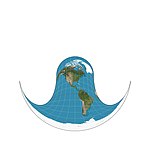
|
Retroazimuthal | Ernst Hammer | 1910 | ||
| Hammer retroazimuthal, back hemisphere | 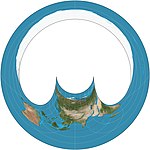
|
Retroazimuthal | Ernst Hammer | 1910 | ||
| Littrow | 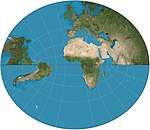
|
Retroazimuthal | Joseph Johann Littrow | 1833 | Also conformal | |
| Armadillo | 
|
Other | Compromise | Erwin Raisz | 1943 |
- ↑ Donald Fenna. "Cartographic Science: A Compendium of Map Projections, with Derivations". Section "The Ortelius Oval" p. 249.
- ↑ Carlos A. Furuti. Conic Projections: Equidistant Conic Projections
- ↑ Jarke J. van Wijk. "Unfolding the Earth: Myriahedral Projections". [1]
- ↑ Carlos A. Furuti. "Interrupted Maps: Myriahedral Maps". [2]

